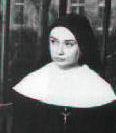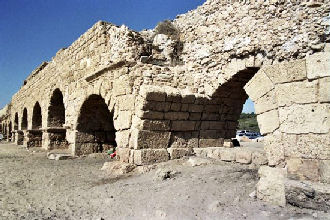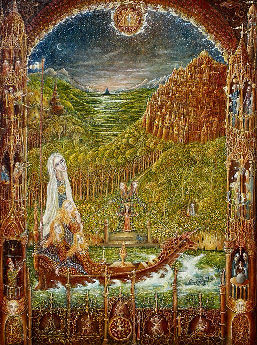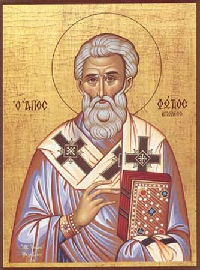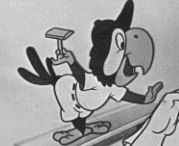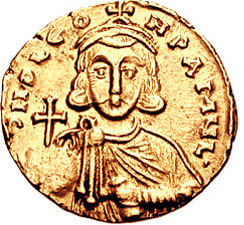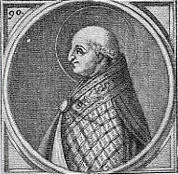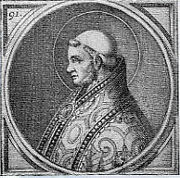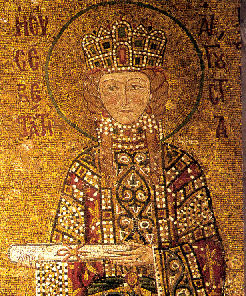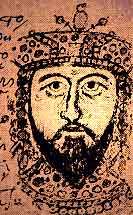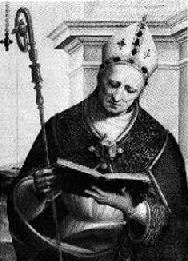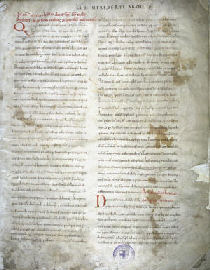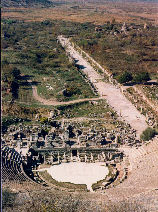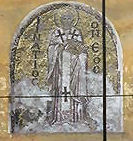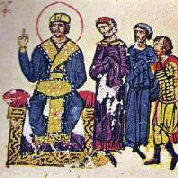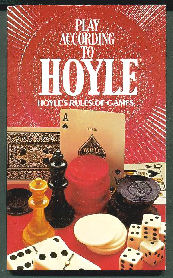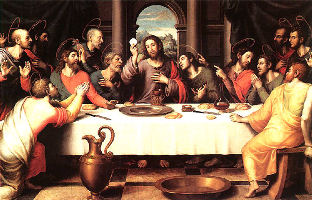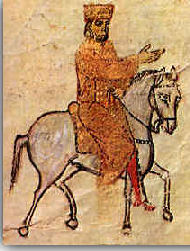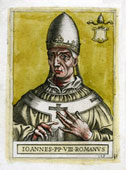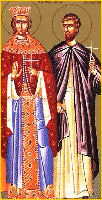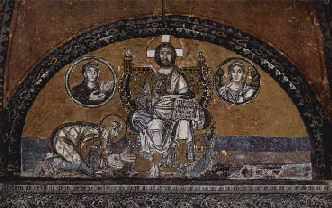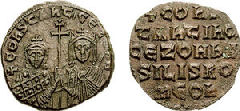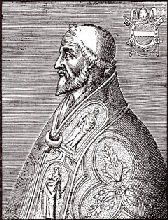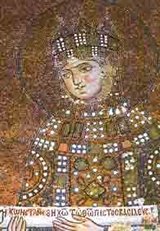Chapter 6: Never the Twain
Much of what Sr. Mary Immaculata drilled into my cerebrum has long since calcified and is no longer easily accessible. The blame is doubtlessly mostly mine; I was more concerned with maintaining an ample inventory of spit balls[1] than in memorizing the day’s catechism lesson. Nevertheless, I remember quite clearly that the Church was supposed to be “one, holy, catholic, and apostolic.” Even a casual reading of Church history, however, reveals that “two” has often seemed an equally appropriate numeric designation.
Medieval Christianity had two very different centers. Constantinople remained the throbbing heart of the Byzantine empire. The empire itself was in decline, but its capital still attracted the educated and cultured. The patriarch’s role was important, but the emperor’s word was law. Rome, in contrast, had become just another town in the Italian peninsula. Over the centuries the Romans had misplaced most of their legendary engineering skill. The aqueducts and other marvels were in ruin. Rome’s inhabitants converted architectural masterpieces into quarries for new construction. The population had shrunk to a tiny fraction of its acme. Hygiene was poor. The only game in town was the papacy, and the popes depended on the Frankish rulers, now promoted to the level of “Holy Roman Emperors,” to protect them from their neighbors. Little or no formal education was available in the west, but many popes were exceptionally clever. They had outfoxed the Lombards who had them surrounded and at their mercy. Would they prove astute enough to deal with their eastern counterparts? The easterners still maintained very close ties to the remnants of the original Roman empire long since based in Constantinople. Eventually the city’s patriarch became the de facto spokesman for the Greek-speaking eastern Church. The eastern Church never ceded the last word to the pope, but it almost always recognized the Bishop of Rome as the ranking patriarch. Despite their precarious position, the Roman Church and its popes were supported by nearly all of western Europe. Additionally, in St. Augustine’s day approximately six hundred bishops of the African Church also sided with Rome. By the end of the first millennium, however, the entire African continent required only three bishops. Two very different cultures prevailed. The guiding principle of the western Church and western civilization was institutionalized ignorance. The first western university was still centuries in the future. In contrast, the patriarchs of Constantinople were for the most part learned men. They studied philosophy, theology, languages, and literature, and they interacted with an Arab world that was relatively advanced in mathematics and science. The sophisticated clerics of Constantinople must have chuckled at the idea of submitting intricate theological judgments to the bishop of that rundown burg in central Italy. Some popes were reportedly illiterate. Few spoke or understood Greek, the language of the New Testament and the empire’s lingua franca since the time of Christ. What must the Byzantines have thought of the immature and raucous teenagers who held the papacy on two different occasions? Half of the medieval pontiffs died before exchanging even one set of letters with the hierarchy in Constantinople. Several were descended from peoples still considered barbarians by the Byzantines. The Roman Church even encouraged the use of images of saints in worship, a practice the east considered idolatrous.The two factions faced totally different challenges. The east coped daily with the rise of the Islamic world, the Umma, which shared a long border with the Byzantine empire. The Saracens and Berbers also had made advances in the west – Africa, Sicily, Spain, and right up to the port of Rome at one point. However, for the most part the west concerned itself with internal matters. A swarm of kings, princes, dukes, margraves, counts, etc., vied for power. Many maintained armies, and most had unquenchable ambitions. One was sometimes crowned as emperor, which often enabled him to appoint or at least approve the pope. In other cases the emperor served at the pope’s discretion. A few popes even mustered their own armies and operated the Papal State as an independent political power.
By contrast, the Greek Church never challenged the civil authority of the Byzantine emperor. The patriarch of Constantinople remained a respected religious authority, but the emperor managed the state’s day-to-day affairs. The influence and power of the other three patriarchs had diminished significantly. By the close of the millennium, there were effectively two Christian worlds, one with a real emperor and a respected patriarch and one with a bunch of princes, a part-time emperor, and, with embarrassingly few exceptions, a ridiculous pope.
* * *
In the west corner wearing trunks festooned with icons of every canonized saint stands the Roman Church. In the east corner wearing gold-lined trunks is the Greek Church. There will be five rounds. Keep it clean, gentlemen. No low blows, no rabbit punches, and no tricks. Sharpie the Parrot has taken up his sign. “Look sharp; feel sharp; be sharp.” There’s the bell.Round 1: Words v. Pictures
Even before the eighth century the empire’s representative in the west, the exarch in Ravenna, usually recognized the pope as spiritual head of the Church. The popes, with no army or police force, needed the emperors to enforce their rulings, but they were often disappointed. Philosophical and doctrinal differences between the eastern Church and Rome were not uncommon.
In the 700’s the two Churches argued over a new issue, the deployment of iconic images (statues, paintings, mosaics, etc.) both inside churches and elsewhere. The western Church prized the images as important teaching tools for prospective barbarian converts and the illiterate faithful. Its bishops argued that their use promoted reverence. The eastern Church felt that icons encouraged idol-worship and constituted a barrier to the conversion of Muslims and Jews, for whom all “graven images” smacked of idolatry. Emperor Leo III, who had declared himself a “great priest,” preached that religious images were explicitly forbidden by the Bible. In 726 he banned all pictures and statuary from churches throughout the empire. He relentlessly persecuted anyone who disagreed with him and ordered religious images destroyed. The popes asserted that the act of destroying images was sacrilegious and therefore sinful. Popes Gregory II (715-731) and Gregory III (731-741) assured the emperor in a series of letters that he was mistaken. Emperor Leo threatened to come to Rome, smash the statue of St. Peter, and lock up the pope. Pope Gregory II replied that he prayed that Emperor Leo’s body would be tortured by demons in order to clarify his mind. His letter included the following incredible statement: “But for the statue of St. Peter himself, which all the kingdoms of the West esteem as a god on earth [emphasis added], the whole West would take a terrible revenge.” The Roman Church had practical reasons for promoting icons. Several monasteries depended on the income from sales of sacred statuary. Moreover, pilgrimages had become a substantial and reliable source of revenue to the papacy. The statues and artwork in Roman churches were already part of the draw. The Church lured pilgrims into Rome and sold them fragmentary relics and holy items as sacred souvenirs. Moreover, most prospective converts in the west were pagans and barbarians, not Jews or Muslims. The Germanic tribes often worshiped household gods; shrines honoring the saints served as convenient substitutes.Pope Gregory II responded to the emperor’s threatened invasion by withholding tax payments and naming himself duke of Rome and the papal holdings. Emperor Leo immediately deployed his army and navy to seize papal territories in Sicily and southern Italy. A Roman synod in 731 excommunicated him. When apprised of this, Leo launched a fleet aimed at eliminating the papacy once and for all. In 733 a fierce storm wrecked the fleet, and in the subsequent years the empire itself was tormented by earthquakes, famine, pestilence, and Islamic invasions. It’s not nice to fool with the statue of St. Peter.
Push came to shove around 750. The leader of the Lombards, the original Liutprand, met with Pope Gregory II in Sutri in 728 and agreed to support the papacy’s struggle against the Byzantines. The Lombards eventually donned their hip boots, conquered Ravenna, and ousted the exarch. The Roman Church was thereafter cut off from the empire. In the east images were destroyed, and relics were dug up and cast into the sea; in the west paintings, statues, mosaics, and relics proliferated.
The 780’s marked the turning point. Empress Irene, the regent for her young son Constantine VI, reversed the iconoclastic decrees and reestablished relationships with the papacy. The Council of Nicea in 787 reunited the two branches of the Church. Although he failed to recover the properties seized by Emperor Leo III, Pope Adrian I agreed to the council’s conclusions. The French bishops, however, balked, due to confusion about the meaning of the council’s acts, which were written in Greek. Since practically no one in France could read the language, the pope’s Latin translation was used. The French thought that the council required images to be worshipped in the same sense that God was worshipped. Many Franks were not that far removed from their pagan idolatry; French bishops worried that they might relapse or revolt. The dispute hinged on the distinction between “veneration,” which can be applied to saints and their images, and “adoration,” which is due only to God. The French thought that the council went too far. In the 870’s Pope John VIII released a new translation that cleared up most of the difficulty. Unfortunately, the east-west rapprochement had no legs. In 814 Emperor Leo V resumed the iconoclastic persecutions. He installed his own patriarch in Constantinople. A new council, in which the pope withheld participation and approval, repudiated the Council of Nicea’s decrees concerning icons. Eastern monks fleeing the persecutions were welcomed in Rome. For twenty-eight years the east and west once again divided over the issue of religious images. Three consecutive emperors arrested Christians who promoted their use.In 842 Emperor Theophilus died. His son, Michael III, was only a toddler. Empress Theodora, the regent, freed everyone imprisoned for use of images. She repealed all of the iconoclastic laws. Whatever icons remained were restored to churches on February 19. The crisis passed, and the Church was more or less unified.
Round 2: St. Nicholas v. St. Photius
A chronic sore point in the east-west relationship was the disagreement over whether the pope could overrule the Patriarch of Constantinople on religious issues. The patriarchs over the centuries generally respected the pope as primus inter pares; the pope was conceded “primacy,” a deliberately vague concept. Several popes argued that Rome should be the first, last, and only source of doctrinal and policy judgments for the Church. Of the fifty-eight popes between 800 and 1050 the one who most firmly pressed this point was Nicholas I, the same pontiff who sent Bishop Formosus to Bulgaria. So, it behooves us to ask Sherman to set the Wayback Machine to the middle of the ninth century to revisit the last “great” pope.
The opponents in this round were St. Nicholas I, the pope, and St. Photius I, the Patriarch of Constantinople. Don’t put too much emphasis on the appellation “St.” in front of their names. Sr. Mary Immaculata and the rest of the Roman Church thought of Photius as an unscrupulous schemer and “the chief author of the great schism” with “insatiable ambition” that led him “to the extreme of dishonesty.”[2] There is no trace of Photius in the Roman hagiography. Instead, the Roman Church has canonized the much less confrontational man known in the eastern Church as an “obscurantist eunuch.” Ignatius was his name, and he was patriarch before both of Photius’s terms.[3] The west has always claimed that Ignatius was forcibly deposed by Emperor Michael III, known as “the Drunkard.” The east, which does not consider Patriarch Ignatius a saint, insisted that he merely resigned peaceably. When Photius himself was deposed, Ignatius was reinstated as Patriarch of Constantinople. When Ignatius died, Photius’s second patriarchate commenced.The Roman Church canonized Nicholas and named him one of the three “great” popes. His reputation in the Greek Church, on the other hand, is roughly of the level of stable sweepings because:
1. He forced an unwanted patriarch on the eastern Church.
2. He excommunicated one of the east’s most revered saints.
3. He insisted upon Rome’s right to amend the creed without consulting the eastern patriarchs.
4. He frequently cited outlandish documents subsequently proven to be forgeries.
This confrontation went beyond value judgments and theological minutiae. Each branch of the Church developed its own set of facts and denigrated the other side’s claims as baseless revisionism. The events during this period and the written correspondence between Pope Nicholas and Patriarch Photius, two undeniably brilliant men, are reminiscent of the letters transcribed in Woody Allen’s classic, “The Gossage-Vardebedian Papers.”[4]
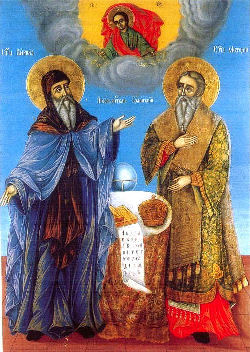
Why did anyone care whether the mass in Bulgaria was celebrated in Greek, Latin, or Slavonic? Well, in those days trade followed the cross as much as the flag. The political benefits of Bulgaria’s affiliation were substantial. Furthermore, funds at this point flowed up from the bishoprics to Rome, not, as in earlier eras, down from the wealthy Romans to the poorer sites in the hinterlands.
The Byzantines had recaptured several territories that Rome considered within its hegemony, namely Sicily, Calabria (the toe of the boot), and Illyricum (roughly equivalent to twentieth century Yugoslavia). Rome wanted these territories back, and the popes had indicated their willingness to cut a deal for them.
On the other hand, the Franks and other German princes seemed to have set their sights on eastern Europe. One reason for the Byzantine emperor’s deployment of troops in Bulgaria was to beat the Franks to the punch.
Philosophical and theological differences had arisen between the two sides. The dispute over iconic images had cooled off somewhat. Two big issues of the day were papal supremacy and the word “Filioque.” Nicholas pressed the case for papal supremacy more passionately than his predecessors had. He insisted that the pope had always had been the sole authority on doctrinal matters. As evidence he submitted a number of ancient “decretals” clearly demonstrating that for centuries bishops and patriarchs had consistently recognized papal authority. The collection, which had been accumulated – probably in France – under the name of a Bishop of Seville named Isidore, included a number of legitimate canonical documents long used as liturgical materials in Spain and France. However, the sections Nicholas employed to buttress his arguments were determined – at a much later date – to be forgeries interpolated in the eighth or ninth century among the legitimate documents. One was the notorious “Donation of Constantine.” Nicholas belittled the office of the Patriarch of Constantinople. He claimed that the city was unworthy of a patriarchate because the Church there was founded by Constantine,[5] not an apostle. Constantinople retorted that it was the heir to the Church founded by several apostles at Ephesus, a major center in Turkey that later became defunct. As such, Constantinople claimed as much right to be called apostolic as any other.And finally there was “Filioque,” perhaps the most controversial word in Christian history. The Latin word means “and the Son.” The Council of Constantinople slightly amended the Nicene Creed in 381. The critical sentence, accepted by all Christians for about five centuries, was “We believe in the Holy Spirit, the Lord, the giver of life, who proceeds from the Father. With the Father and Son he is worshipped and glorified.” In the west the word “Filioque” had some years back been inserted to transform the critical clause to “who proceeds from the Father and the Son.” The eastern Church had never agreed to this alteration, and, in fact, many eastern clergy considered it heretical. The issue had for the most part stayed under Constantinople’s radar until the quarrel between Nicholas and Photius became incendiary.
The conflict began when Patriarch Ignatius excommunicated Gregory Asbestas, the Archbishop of Syracuse, for insubordination. Not long thereafter the young wine-loving Michael III rose to the level of emperor after using traditional Byzantine methods to dispose of his rivals. Ignatius, himself the son of an emperor, resigned as soon as Michael had snatched the reins of power. Whether the resignation was purely voluntary is not crystal clear, but the Byzantines carefully crossed all their tau’s.[6]Photius, a brilliant layman who had risen through the ranks of the emperor’s retinue, then received all of the orders needed by a patriarch in a five-day course of ceremonies. He was consecrated by none other than Gregory Asbestas.
Ignatius’s supporters appealed to Pope Nicholas to intervene. Photius and Michael also welcomed the pope’s judgment. The pope sent two legates, Rodoald of Porto and Zachary of Anagni, to Constantinople to assess the situation. They certified that everything had proceeded according to Hoyle. Whether the legates were convinced by the strength of the arguments, by bribes, by threats, or by some combination of the three is still disputed.A letter sent to Pope Nicholas by one of Ignatius’s friends painted an entirely different picture of ruthless imperial interference in a Church matter and unjust exile of a saintly priest. On the basis of this information the pope excommunicated his own legates. He also conditionally excommunicated Photius unless he immediately relinquished his see. The main reasons cited for this action were:
1. The termination of Ignatius’s patriarchate was illegal.
2. Photius had skipped the “interstices,” the required waiting periods between the various ranks to become patriarch. In Pope Nicholas’s era the Roman Church had not yet sanctioned the fast track repeatedly used by newly elected popes in subsequent centuries.
3. Gregory Asbestas, who had consecrated Photius, was still under ban of excommunication and therefore ineligible to perform the ceremony.
Did Patriarch Photius recognize in these charges the divinely inspired message of the Vicar of Christ? Not exactly. He even went Nicholas’s writ of excommunication one better. Not only did he denounce Nicholas as a heretic and anathema, he also excommunicated everyone who employed the Latin rite, that is, all of western Christianity! The mass excommunication issued by Photius condemned specific doctrinal shortcomings of the Roman Church’s approach:
1. Latins do not fast on Saturday.2. Latins use unleavened bread for the Eucharist.
3. Latins begin Lent three days too late, on Ash Wednesday.
4. Priests in the west are not allowed to marry.
5. Latins added the “Filioque” to the creed, an heretical interpretation of the Trinity and a deliberate violation of the agreement at Chalcedon.
Photius also asserted that Nicholas’s expulsion of the papal legates was baseless. He called the pope and the Latins “forerunners of apostasy, servants of Antichrist who deserve a thousand deaths, liars, fighters against God.”
Moreover, the Romans found the style of the communications from Photius and Emperor Michael insufferable. The letters belittled the Latin language, which no doubt lacked much of the sophistication of Greek. They called the pope’s capital “Old Rome,” which was a term of respect in the Byzantine world where imperial officials proudly called themselves “Romans,” but in Rome it was taken as a slight. There were doubtless intentional insults, as well.
Fate rang the bell just as the two combatants seemed about to take off the gloves. Pope Nicholas died before he could learn about the patriarch’s actions. Shortly thereafter Emperor Michael III was murdered and overthrown by Basil I. Photius was forced to resign. A council of bishops was then called by Pope Adrian II in Constantinople. Despite the location it was dominated by westerners. This council, which has never been accepted by the eastern Church, upheld Photius’s excommunication and deposition.The deposed patriarch then languished in exile for seven years, during which time he wrote letters and ingratiated himself with both Emperor Basil and Patriarch Ignatius. The emperor who had deposed and exiled Photius eventually thought so highly of him that he hired him to tutor his own son.
When Patriarch Ignatius died on October 23, 877, a groundswell of support for Photius arose in Constantinople. Basil appealed to Pope John VIII, the same pontiff who excommunicated Bishop Formosus. John replied in writing, and Photius – showing tremendous papal potential[7] – kept the original to himself. He made a copy of this epistle, but he carefully redacted the objectionable parts before distributing it. After several exchanges the pope absolved Photius of all wrong-doing, and both sides lived happily ever after.Well, for a little while, anyway. None of Photius’s concerns about the Latin rites and especially about the “Filioque” were addressed. Photius never recanted his charges against Nicholas and the Latins.
Sr. Mary Immaculata could easily describe this conflict in the black and white terms with which she felt comfortable. To wit, Nicholas was a great pope inspired by the Holy Ghost.[8] Photius was a brilliant man who submitted to the sin of pride, a tool Satan often used to delude Christians. We were warned of this danger whenever someone in class acted uppity.
In the ensuing decades the papacy became first a laughable irrelevancy and then an abomination. For over a century it served as a fiefdom for two related families in Tusculum. Who could take the institution seriously when popes were digging up the corpses of their predecessors, when shameless women were installing their boyfriends and relatives as popes, when red lights decorated the Lateran Palace, and when the pope himself – astride a Roman senator – led an army of thugs out looking for territory? Few popes during this chaotic period could spare much time to worry about schisms or potential heresies.
Round 3: Sergius v. Nicolas Mysticus
The next dispute was an excellent illustration of the fact that in the Dark Ages the conduct of the rulers in Constantinople could be nearly as outrageous as it was in Rome. In 886 Emperor Leo VI inherited from his father Basil I[9] a Byzantine Empire as powerful as it had ever been since Constantine’s time. During Leo’s long reign, however, he lost huge chunks of it to the Bulgarians in the north and the west and the Saracens in the south and east. The Kievan Rus attacked Constantinople itself and had to be bought off.
Emperor Leo was determined to leave the remnants of his empire to a male heir, but he did not enjoy good luck with the sacrament of marriage. His wives seemed incapable of bearing male children and tended to last only a few years. His first bride, Theophano, forced on him by Emperor Basil, died in 897. The second, Zoë Zaoutzaina, expired two years later. Church doctrine forbade another marriage, but Leo took a third wife, Eudokia Baïana, anyway. She too passed away childless in 901. Aside from carnival knife-throwers married to their assistants, who goes through three wives in four years? After the third funeral the emperor changed tactics. He took a mistress named Zoë Karbonopsina. It worked; she delivered him a son. Emperor Leo did the honorable, if illegal, thing and made a relatively honest woman out of Zoë. She became wife number four. Nicolas Mysticus, Patriarch of Constantinople,[10] vociferously protested the marriage. Leo in turn showed Nicolas the door. The deposed patriarch protested to the pope. Unfortunately for Patriarch Nicolas, the pope in 906 was Sergius III, the fellow who was notorious both for impregnating a fifteen-year-old with a future pope and for resurrecting the charges against the long-dead Pope Formosus. Sergius sided with Emperor Leo, who may have seemed like a kindred spirit.Pope Sergius’s ruling outraged the clergy in Constantinople. The bitterness of the reaction even surprised Emperor Leo. On his deathbed he restored Nicolas Mysticus to the patriarchate. Then in 920 a synod was convened in Constantinople. It declared all fourth marriages illegal and, even though Pope John X sent a representative, made no concessions to Rome at all.
The story was begging for an ironic ending. Emperor Constantine VII Porphyrogenitus, the son of Zoë and Emperor Leo, affirmed the illegality of fourth marriages even though he himself was the product of one, or at least its romantic prelude.What would Sr. Mary Immaculata have thought of Pope Sergius III? Not only did he side with a philandering emperor over a law-abiding patriarch. He also allegedly fathered two future popes; one was even conceived while he was supposed to be busy poping. He was behind both ludicrous posthumous condemnations of Pope Formosus. He voided the authenticity of so many priests and bishops that no one could identify the legitimate clergy. I suspect that S’ter would have admonished us that the pope’s behavior was a matter between Sergius and the Lord, Who surely did not require our advice. She might also have explained that the Church’s survival during such troubled times emphasized the beneficent safeguarding of the Holy Ghost.
Round 4: Romanus v. The Romans
Romanus, the scion of the Tusculum family who served as civilian ruler of Rome during the pontificate of his brother, Benedict VIII, assumed the leadership of the Church as Pope John XIX in 1024. Early in his pontificate he received a delegation from the Greek Church and consulted with them on the Q.T. The Byzantine clerics laid an unusual offer on the table. They proposed that the pope promote the Patriarch of Constantinople to the rank of “ecumenical patriarch,” effectively acknowledging him as head of the eastern Church. Popes would no longer expect the Patriarch of Constantinople to submit doctrinal and procedural matters to Rome; the patriarch would render judgments for the eastern Church. In effect he would become co-pope. In return for this concession, the Byzantines brought an extremely large amount of cash.
By all indications, Pope John was ready to ink the agreement, but it never was finalized.[11] Although his negotiations with the Byzantines were conducted in secret, somehow word leaked out; maybe someone noticed how low those gold-laden Byzantine barges were sitting in the water. The pope’s monopoly on religious judgments was one of the few remaining pillars of the pitiful Roman economy. Both the Roman clergy and the laity were appalled at the prospect of the pope sharing his power, especially since he never offered to share the loot. The scheme’s exposure left the pontiff little choice but to dismiss the easterners without ceding authority to the patriarch. It must have killed him to see those ships weigh anchor.How could any pope justify such an outrageous deal? Maybe he felt that as vicar of Peter he could use the hereditary Keys to the Kingdom in whatever manner he judged suitable. What in scripture prohibited him from asking the guy in the orange apron at Home Depot to grind out a duplicate set of keys? In Sr. Mary Immaculata’s eyes, of course, this nefarious plot was most likely foiled by the Holy Ghost’s timely intervention.
History, however, provides a tantalizing possibility. The Byzantine clerics almost certainly had a potentially workable idea, but prehaps they presented it just a little too early. John XIX’s successor was, in fact, Benedict IX, the young man who sold his second papacy to John Gratian. By 1045 the Holy Ghost evidently endorsed a free-market approach to the papacy.
Sr. Mary Immaculata would certainly have discouraged speculation as to how Church history might have changed if the pope had consummated the deal. Her students, or at least the male ones, were always eager to try anything that she warned against, so speculation on this subject is essentially inevitable. Would the Roman Church eventually have tried to revoke the patriarch’s authority? I think so. The Church could only tolerate two infallible heads if they were both on Zaphod Beeblebrox’s shoulders. It is inconceivable that a thousand years would go by without significant differences over matters of faith and morals arising between the pope and the ecumenical patriarch. Over the course of the first millennium, the two had repeatedly denounced each other as heretics. By John XIX’s day, the two sides already bickered over the calendar, any number of liturgical practices, the use of religious icons, and the “Filioque” issue.If a future pope deemed it necessary to renege on the agreement, how might he explain away Pope John XIX’s actions? There is really no way to predict, but many subsequent popes were so devious in so many ways that surely one would have contrived a viable solution. This was their specialty. Ironic epilog: even without official papal approbation, the patriarchs of Constantinople started applying the epithet “ecumenical” to themselves within a few decades.
Round 5: Leo v. Michael Cerularius
After Pope Nicholas the Great, no haloes were to be seen in the next forty-seven official pontifical portraits. The unsaintly streak finally was broken in 1049. Bruno, a German who was a cousin of Emperor Conrad II, was appointed pontiff by Emperor Henry III in a determined attempt to reform the Church after the unspeakable scandals of Benedict IX and the suspicious death of his successor, Damasus II. Bruno accepted the appointment as Pope Leo IX, but he wisely insisted upon being elected pope by the Roman clergy. The Romans overlooked his blonde locks and his preference for strudel over spaghetti and voted him in.
Leo occupied Peter’s throne until 1054. His pontificate saw the conflict between Rome and Constantinople reach the breaking point even though the struggle with the eastern Church was never the focus of his attention. He devoted most of his term to his Reformapalooza tour. The synods that he conducted in Germany, France, Italy, and Sicily emphasized two issues: for the clergy the elimination of simony and promiscuity, and for everyone the restoration of respect for the primacy of Rome. To show his seriousness he excommunicated and replaced several bishops who were reluctant to toe the line. At first France resisted his programs, but he was generally successful at restoring to the Roman Church a degree of respectability that had been absent for many decades.In 1053 Pope Leo’s attention was drawn to southern Italy, then split among several powers – the Saracens, the Byzantines, the papacy itself, and a new group that had stunningly conquered great swaths of territory with an incredibly small number of troops, the Normans. The pope undertook military action against the Normans. They were Christians, but in their unstoppable march through Sicily and southern Italy the Norman army had repeatedly plundered monasteries and churches to finance its campaigns. The Normans had also seized several papal states, which they ruled for their own benefit.
The pope returned to his native Germany to raise an army. The assistance that he expected from Holy Roman Emperor Henry III never materialized. Instead, he brought back to Italy a much less formidable army raised by his own family. Although the Byzantines seemed ready to help him, the Patriarch of Constantinople, Michael Cerularius, feared lest the pope gain influence over the (Byzantine) emperor. The Byzantine general, Agyros, argued successfully in favor of the papal alliance. The patriarch was furious enough to excommunicate Agyros and then spread the word in the east that the Romans had outlawed the Greek rites in Italy. The fabricated reports of such outrages inflamed attitudes in Constantinople. By the time that the papal army faced the Normans, it was not politically feasible for the Byzantine emperor to aid the pontiff.Pope Leo therefore led a force of Germans augmented by an Italian contingent to face the Normans on June 18, 1053, at Civitella in Apulia. Although outnumbered, the Normans routed the Italians and then crushed the German troops just as they had steamrolled nearly all opposition in Italy. They even took Pope Leo prisoner, but they treated him with the utmost respect and, in fact, offered an alliance that the pontiff eagerly accepted. He was held captive by the Normans for nine of the ten remaining months of his papacy, but he maintained contact with the outside world and ran the Church’s affairs with little or no interference.
The Normans had designs not just on the territories controlled by the Arabs and the pope but also portions of the Byzantine empire. In Constantinople the sudden alliance of the Normans with the pope, a German noble by birth, was justly perceived as a serious threat. At about this time another Leo, the Bishop of Achrida, acting on behalf of Michael Cerularius, addressed a letter to the Bishop of Trani, an Italian city in Apulia subject to the patriarchate of Constantinople. The Apulian bishop relayed the letter to the French bishops and to the pope himself. The missive harshly criticized several western liturgical practices that the Greek Church labeled as “innovations.” It was translated into Latin by Cardinal Humbert of Moyenmoutier. Only the cardinal’s Latin version has survived.
In an epistle addressed to the patriarch himself Pope Leo responded to the charges in a surprisingly respectful way. He also sent a delegation to Constantinople to settle the matter. It was headed by Cardinal Humbert, an alumnus of the same charm school attended by Michael Cerularius. Michael refused to meet with the westerners, who had brought a list of counter-charges, including a complaint about the patriarch’s unauthorized (and unpurchased) use of the word “ecumenical.” Also in Cardinal Humbert’s possession was a writ of excommunication against Michael Cerularius and anyone else who criticized the Church of Rome.
Humbert brandished a copy of the Donation of Constantine and quoted it to emphasize the unlimited authority of the pope. Surely the Byzantines must have ridiculed Humber for resorting to use of this bogus account. After all, Constantine was the George Washington of the Byzantine Empire, and Eusebius, the Arian cleric who really baptized the emperor on his deathbed, was extremely famous in the east. Furthermore, unlike Rome, Constantinople was still a sophisticated intellectual center; no outsiders ever gave orders to its residents. Tensions must have run high on the Bosporus.
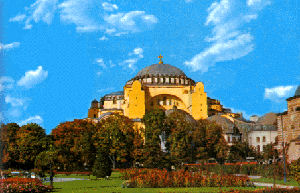
The patriarch immediately convoked a synod to declare the papal delegation anathema. His letter to the Patriarch of Antioch itemized the charges against Rome, including the use of the “Filioque,” a charge omitted from the original letter to Apulia. The other three patriarchs aligned themselves with Constantinople.
The split has never healed. The eastern Church is now know as the Greek Orthodox Church and its affiliated Churches. The patriarch calls himself “ecumenical” to this day.
Responsibility for the schism cannot really be laid at Pope Leo’s doorstep. He was already dead when Humbert reached Constantinople. History gave the pontiff no reason to think that the outcome of this squabble would be irreversible.
Sr. Mary Immaculata taught us about the schism. She emphasized what a tragedy it was that over the centuries the arrogance and pride of the patriarchs prevented them from recognizing the authority of the Holy Father and deprived so many Christians of communion with the one true Church. We prayed for their misguided souls fairly often.

[1] Spit balls are called spitwads in some dialects. Proper technique requires wadding one-fourth to three-fourths of a sheet of loose-leaf notebook paper into a ball and then immersing it in one’s mouth long enough to form a juicy spheroid. A supply of two or three could easily be secreted for immediate launch whenever the teacher was called from the classroom.
[2] The Catholic Encyclopedia, op. cit., Vol. III, pp. 43-45.
[3] Ignatius and Photius dominated the eastern Church for forty years. Ignatius was patriarch from 847 until 858. Photius ruled until 867, at which time Ignatius resumed his patriarchy. Photius returned to rule from 877 until 886.
[4] This short story, describing a game of chess by mail, originally appeared in The New Yorker. The opponents disagree about the state of the board (one early move was supposedly lost in the mail). Each interprets and adjusts the other’s subsequent moves to his own advantage.
[5] Constantine, who is a saint in the eastern Church, considered himself an apostle.
[6] The letter iota is not dotted in Greek.
[7] One of his sons actually became Pope Theodore II!
[8] In our class the third person of the Trinity was still called by this name. Perhaps because of Casper’s popularity, references were later changed to “Holy Spirit.”
[9] Some have speculated that the man whom Basil overthrew, Michael III, was Leo’s real father. At one point during Leo’s teen years Basil almost had the young man blinded. Basil died in a hunting accident, but on his deathbed he claimed that he had been assassinated and speculated that Leo had instigated it.
[10] And bearer of the coolest name in Church history.
[11] Greisley has speculated that the deal may have been consumated. “… nor will it be far from the truth to conjecture that the gold and silver remained at Rome, and hopes were transported to Constantinople.” Op. cit., p. 60.
 | |
 | |
Bankable Bar Bets
$ The Patriarch of Constantinople, Photius I, excommunicated the pope and all Christians who used the Latin rites. Pope Nicholas I already had excommunicated the patriarch. Photius is considered a saint by the eastern church.
$ Ignatius served two terms as Patriarch of Constantinople for a total of nearly twenty years. The western Church considers him a saint, but the eastern Church does not.
$ The western Church slightly amended the Nicene Creed to add the word “Filioque” without obtaining agreement from the east.
$ Pope Theodore II was the son of the excommunicated Patriarch Photius I.
$ The Byzantine Emperor Constantine VII declared that fourth marriages were illegal even though his own mother was his father’s fourth wife.
$ An embassy from the Byzantine Empire tried to bribe Pope John XIX into sharing his authority with the Patriarch of Constantinople. The pope was ready to agree, but the Roman citizenry balked.
$ The Greek Orthodox Church split from the Roman Church in 1054 when Cardinal Humbert left behind a papal bull excommunicating the Patriarch of Constantinople, Michael Cerularius,s and others. The excommunications were later lifted, but the schism has persisted.
